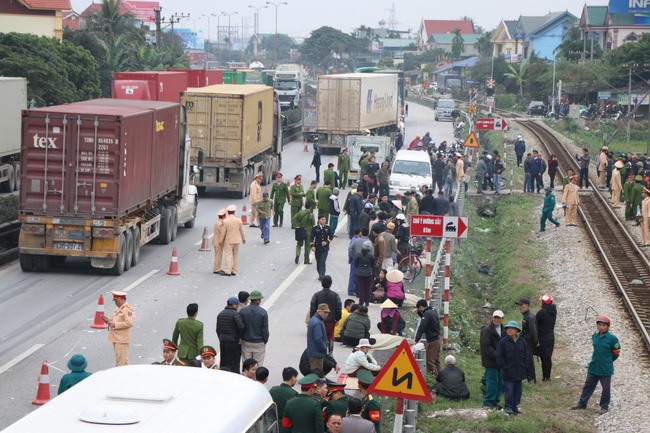 Op-Ed
Op-Ed

Somehow the most basic rule of driving is being ignored. Despite thousands of warnings, drunk and drugged drivers still risk theirs and other’s lives on the roads daily. Public health messaging about the dangers of operating a vehicle under the influence of alcohol or drugs is falling on deaf ears.
 |
| The scene of traffic accident in Hải Dương Province on January 22, in which truck driver Lương Văn Tâm crashed into a group of eight people walking along the edge of the National Highway 5, killing them all. — VNA/VNS Photo |
Thu Vân
Somehow the most basic rule of driving is being ignored.
Despite thousands of warnings, drunk and drugged drivers still risk theirs and other’s lives on the roads daily. Public health messaging about the dangers of operating a vehicle under the influence of alcohol or drugs is falling on deaf ears.
Imagine if one of your loved ones died while sat on their motorbike at a red light, killed by a drunk or drugged driver! Would your anger have any limit?
Here in Việt Nam, if you don’t have a car and just drive a motorbike or bicycle or even walk, it is almost a daily risk.
If governments and safety organisations across Việt Nam needed a fire lit under them to boost public education around the dangers of drunk and drugged driving, fatal accidents in the past few weeks should have done the trick.
On January 22, truck driver Lương Văn Tâm crashed into a group of eight people walking along the edge of the National Highway 5, killing them all.
He told police he had taken methamphetamine several days earlier. He tested positive for meth the night of the accident.
Tâm was prosecuted and put into custody. His employers, Newpro, had their licence suspended for three months. This is a much needed action from authorities, though it might be too late.
Earlier on January 13, HCM City police drug tested 48 truck drivers and found seven tested positive for heroin.
On January 2, a container truck was travelling on National Highway 1A when its driver lost control and rammed at least 20 motorbikes waiting at the traffic lights in Bến Lức District, 60km southwest of HCM City.
Four people were killed and 16 others were badly injured.
The driver, Phạm Thanh Hiếu, was found later to have high concentrations of alcohol in his blood and also tested positive for heroin.
Drug use is not rare among Vietnamese truck drivers, who have heavy workloads and many drivers have admitted that driving continuously for more than four hours was common.
In a fatal accident last July in Quảng Nam in which 13 people died, the truck driver was reported to have been working for more than 12 hours.
As a result, many drivers have resorted to drugs like meth to keep them awake as they are required by transport firms to work long hours beyond their normal physical capacity.
An inspection campaign by the transport ministry in 2014 found 526 out of 136,000 drivers tested positive for drugs.
This shows we need new testing procedures, more public awareness campaigns and increase law enforcement.
Hà Nội City’s Department of Transport has taken a step and required all transport firms in the capital city to test all drivers for drugs. All tests must be completed before to the end of February, and any drivers testing positive for drugs must be laid off.
This is a welcome move, but such examinations should be done on a more regular basis and with stricter obligations. Transport firms must also supervised closely on the workload assigned to drivers, which should be seen as the one of the main roots of the problem. If drivers are still forced to work long hours, they will continue to take risks.
In case of serious accidents, drugged and drunk drivers should have their licences revoked for good. Currently, Vietnamese law only allows for revocation of a driver’s licence for up to six months. But given the danger intoxicated drivers pose, shouldn’t we reconsider this?
As long as drug users are behind the wheel, many innocent lives are under threat. Their employers should be punished strictly and subject to criminal proceedings. Why not, when we think of the fact that their drivers, whether under the company pressure or being irresponsible when driving, have taken the lives of others? How much money is a life worth? How much money can compensate for the pain of a bereaved loved one? Children lose parents and parents lose children needlessly and tragically.
While traffic accidents are still killing people every day, we cannot afford to tolerate anyone involved in creating the risk. Not anymore.
To deal with traffic accidents from truck drivers, recommendations also included better traffic diversions, better traffic planning and infrastructure and increasing the number of random breath and drug tests .
The problem of drug and alcohol abuse among drivers has persisted for years, but it is the inaction of agencies that is to blame for many fatal traffic accidents caused by trucks, and other traffic accidents.
Khuất Việt Hùng, vice head of the National Committee for Traffic Safety, said safety in the traffic system depends largely on the design and management of the system. When traffic safety is poor and doesn’t improve after campaign and campaign, clearly there are flaws in transport planning.
In the last five years, the number of fatalities has shown a gradual downward trend, but still never dropped below 8,000. In 2016, the number of deaths even went up by 14 compared to 2015, nullifying any perceived improvements in road safety.
Why is it that while we’re living in peace time, the number of casualties and injuries from road accidents rivals the carnage of war? Why should we risk our lives on the roads ever day? Law enforcement is not strict enough and the transport sector is clearly not doing enough! It’s inaction.
The Government and the road transport sector need to wake up to reality now and make road safety a priority and view the issue as a major threat to public health. Or there will be more fatal accidents to lament over. — VNS




